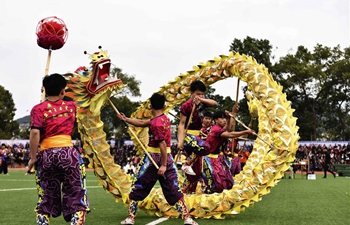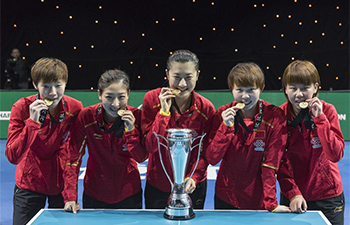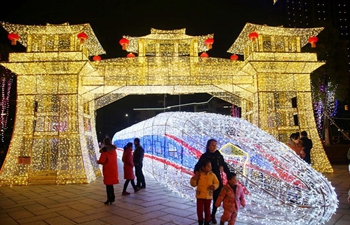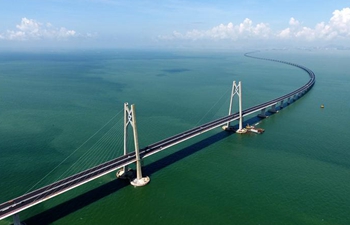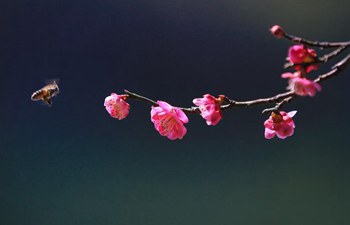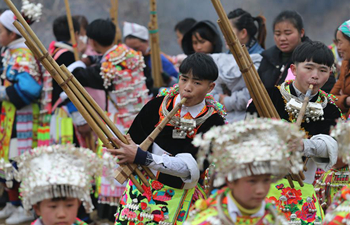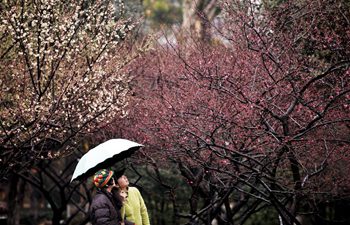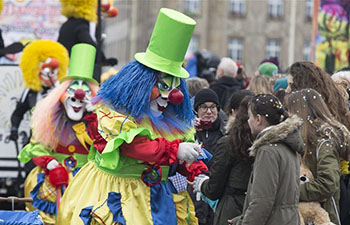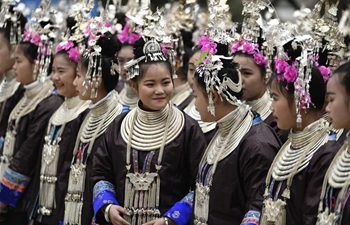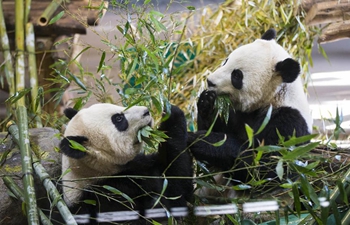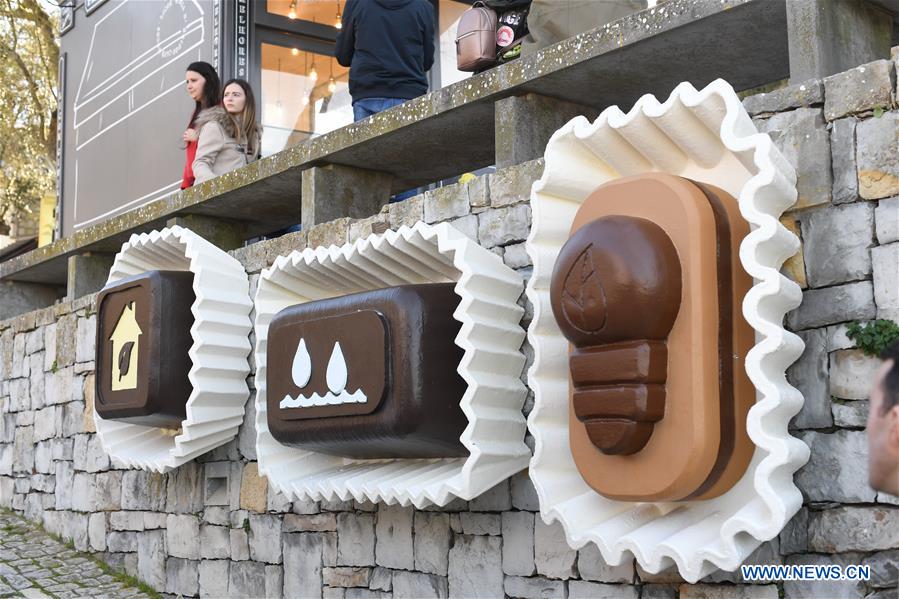
Chocolate-shaped decorations are seen on a wall during the 16th Obidos International Chocolate Festival in the Portuguese village Obidos on Feb. 25, 2018. The festival opened on Friday and will last until March 18. The festival committee picks a theme every year and this year's theme is climate change. (Xinhua/Zhang Liyun)
by Jethro Soutar
LISBON, Feb. 25 (Xinhua) -- Day-trippers from various parts of Portugal enjoyed a tasty treat on Sunday as they descended on Obidos, a hilltop town on the west coast, for a creative chocolate festival.
The 16th International Chocolate Festival, which opened on Friday and will last until March 18, has been an annual tradition for the town since 2002.
Visitors indulged in cooking displays, workshops, exhibitions and tastings, with dozens of market stalls selling every imaginable chocolate product.
"I just made spaghetti bolognese out of chocolate, and now we're going to make a chocolate pizza!" Tiago, aged four, enthused about his little cooking adventure as he was taking part in one of the molecular cooking workshops tailored to families.
He came with his parents, Fred and Lina, from the central city of Fatima. "We're his sous-chefs," joked Fred.
Carla and Rosa, in their early sixties, had come up for the day by coach from Albufeira, on Portugal's south coast. "It's great, a total one-off," said Carla, "and the strawberry kebabs dipped in chocolate were worth the trip alone!"
Obidos is a picturesque town 85 km north of Lisbon, a jumble of white cottages and cobbled streets contained inside the walls of a medieval castle. As a popular tourist destination, the town organizes events throughout the year, including theme markets and book festivals.
But the event that has the most visitors licking their lips is the International Chocolate Festival. The event began in 2002 when Sandy Lisberg, an American living in Obidos, came up with the idea.
Prior to the festival, Obidos had no chocolate tradition to speak of. In food and drink terms, it was best known for producing a cherry brandy called ginja. When the chocolate festival first launched, local traders entered into the spirit of things by making tiny cups out of chocolate and serving ginja from them. These days no trip to Obidos is complete without drinking a ginja from a chocolate cup.
The region did, however, have a confectionery tradition. The nearby convent of Sao Miguel de Gaeiras was historically famous for its "egg fardels", a sticky sweet made from egg yokes and sugar.
At this year's festival, Ceu Carvalho took inspiration from the nuns to launch a new bonbon, "the Pearl of Obidos", a sort of curate's egg with a "fardel" mixture at the center.
Carvalho is head-chef and product manager at Ceu Chocolatier, a confectioner based in Sintra, a town some 30 km northwest of Lisbon. She unveiled the new bonbon live on stage in one of the festival's daily show-cooking displays, and got "really positive feedback."
There was more innovation to be found at the LX Beers stand. The Lisbon brewer produces a chocolate beer called Choco Late especially for the festival. This is the third year LX has participated and the recipe, which involves adding chocolate to the water, yeast, malt and hops, has been fine-tuned each year.
For many visitors, the chocolate sculptures are the highlight of the festival. Once finished, the sculptures are put on display inside a marquee while visitors can watch works-in-progress being made in a windowed studio.
The creations are the responsibility of Brazilian chef Abner Ivan, whose involvement in the festival dates back to 2012, when he triumphed in a chocolate dessert-making competition.
"The festival committee picks a theme every year and we have to come up with designs based on that," said Ivan. "This year's theme is climate change ... We'd combine things that have happened because of climate change in the past, and things that might happen in the future, so that the younger generation could think about what actions need to be taken."
The sculptures include a panda, symbol of the World Wildlife Fund, and a polar bear, whose habitat has been threatened by melting ice caps. Another features the top half of the Statue of Liberty, with the rest submerged beneath rising sea levels, beside the bottom half of the Eiffel Tower, symbolizing a lack of progress on the Paris Agreement, an international effort to tackle climate change.
The sculptures are made from cocoa butter and decorated using food coloring. The panda, for example, which is 1-meter tall, required 300 kg of chocolate and took 112 hours to make.
Joao Morais was visiting from Sintra with his teenage children, Mario and Claudia. "My favorite was the factory sculpture," said Mario, referring to a design that showed a polluting factory melting planet earth.
His father agreed, adding that "it also carried the strongest ecological message. You couldn't help but think about what we're doing to the planet and how slow we are to change our ways."
But Claudia's favorite was the last sculpture in the room. "I liked the renewable energies sculpture best," she said of a model that combined a solar panel and a wind turbine, a message of hope.




